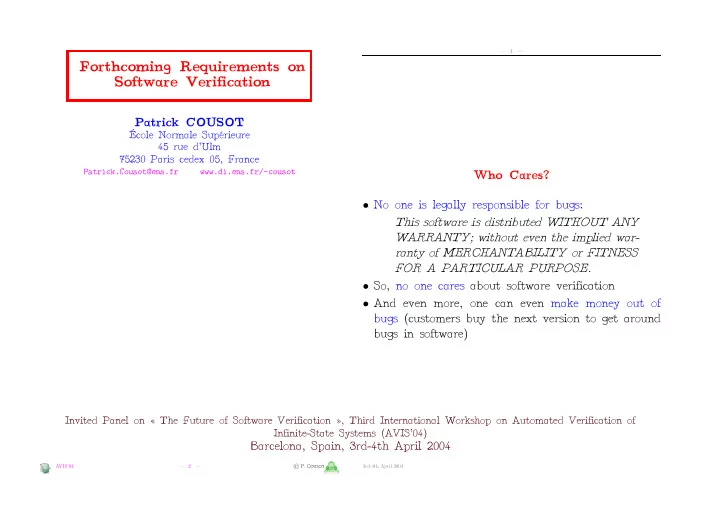

— 1 — Forthcoming Requirements on Software Verification Patrick COUSOT École Normale Supérieure 45 rue d’Ulm 75230 Paris cedex 05, France Patrick.Cousot@ens.fr www.di.ens.fr/~cousot Who Cares? › No one is legally responsible for bugs: This software is distributed WITHOUT ANY WARRANTY; without even the implied war- ranty of MERCHANTABILITY or FITNESS FOR A PARTICULAR PURPOSE. › So, no one cares about software verification › And even more, one can even make money out of bugs (customers buy the next version to get around bugs in software) Invited Panel on « The Future of Software Verification », Third International Workshop on Automated Verification of Infinite-State Systems (AVIS’04) Barcelona, Spain, 3rd-4th April 2004 AVIS’04, — 2 — ľ P. Cousot ľ P. Cousot 3rd-4th April 2004
Who Really Cares? Current Research Results › The victims (for lost data, money and even lives) › Research is presently changing the state of the art (e.g. ASTRÉE) › Victims get no repair › We can check for the absence of large categories › So no one really cares of bugs (may be not all of them but a significant › The general public might lose confidence in software- portion of them) based technology (this is one of the explanations for › The verification can be made automatically by me- the success of open software) chanical tools › Some bugs can be found completely automatically, without any human intervention — 3 — — 5 — Why No One Cares? The Next Step (5 years) › Software designers don’t care because there is no risk in writing bugged software › If these tools are successful, their use can be enforced by quality norms › The law/judges can never enforce more than what is offered by the state of the art › Professional have to conform to such norms (other- › Automated software verification by formal methods wise they are not credible) is undecidable whence thought to be impossible › Because of complete tool automaticity, no one can be discharged from the duty of applying such state › Whence the state of the art is that no one will ever of the art tools be able to eliminate all bugs at a reasonable price › Third parties of confidence can check software a pos- › And so no one ever bear any responsability teriori to trace back bugs and prove responsabilities AVIS’04, — 6 — ľ P. Cousot ľ P. Cousot 3rd-4th April 2004
A Foreseeable Future (10 years) › The real take-off of software verification must be enforced › Development costs arguments have shown to be in- effective › Norms/laws might be much more convincing › This requires effectiveness and complete automation (to avoid acquittal based on human capacity limita- tions arguments) — 7 — Conclusion › The state of the art will change toward complete automation, at least for common categories of bugs › So responsabilities can be established (at least for automatically detectable bugs) › Whence the law will change (by adjusting to the new state of the art) › To ensure at least partial software verification › For the benefit of all of us AVIS’04, — 6 — ľ P. Cousot 3rd-4th April 2004 — 8 — ľ P. Cousot
Recommend
More recommend